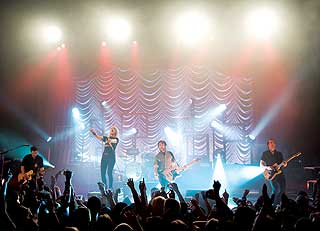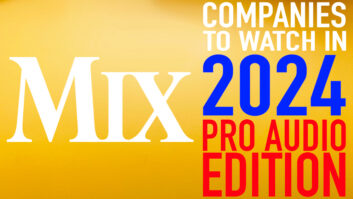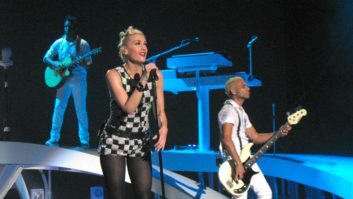
Paramore, from left: guitarist Josh Farro, vocalist Hayley Williams, drummer Zac Farro, bassist Jeremy Davis and guitarist Taylor York
For front-of-house engineer Jason Decter (previously with Panic at the Disco!) and monitor engineer Travis Bing (Little Big Town), who are both Paramore first-timers, the name of the game for the current Paramore tour is re-creating the album sound onstage. At each sold-out club/theater date, the hundreds of teenaged fans have come to hear such radio-friendly songs as “Misery Business,” “Ignorance” (from the recently released Brand New Eyes) and “I Caught Myself” (on the Twilight soundtrack), and the engineers want to ensure that the fans are satisfied. Their plan of attack involves carrying digital desks (a pair of Digidesign Profiles), using little in the way of effects and keeping Hayley Williams’ vocals on top. The tour is relying on house racks and stacks (a Meyer Sound system running through Lake Contour at the Warfield); Clair Global provides all other gear.
Decter had his snapshots programmed a certain way since pre-production, but chose to go back to one scene doing manual cues for the entire set to have more fun with the mix each night. “For the past week or two, I’ve been mixing the show without any snapshots. I changed it up a little bit from one extreme to the other. I was getting bored just saying, ‘Next, next, next’ [laughs]. I have a Crane Song Phoenix on a lot of my subgroups — sometimes on my left and right — but I have a new trick: I come out AES in the desk and go into the Crane Song HEDD Harmonic device and convert it in that instead of the desk so it frees up some DSP. I only run on two cards, maybe three — two DSPs on the third card — but I have four cards in the desk. This gives me more plug-in power, more horsepower. Because I didn’t know what I was going to encounter with the band as far as plug-ins, I’ve got it pretty limited to the Phoenix and Smack!, and I put Hayley’s vocal out on an outboard vocal Distressor and it goes right through the P.A.

Front-of-house engineer Jason Decter
“I just try to hit the keys [that are on] the record,” Decter continues. “They want to create that feel with a bit of moving air on the bottom. We’ve had open discussions and I record every night [to a Pro Tools HD rig] so the band can hear what’s going on. I just go for the open, non-compressed but still in-your-face sound. I leave the dynamics in; I don’t squash anything to the point where it sounds bad.”
Bing is also using little in the way of effects — a bit on drums, keys and acoustic guitars: “Nothing crazy,” he says. “Just general hall, reverb and plate sounds.” He is also giving each bandmember a specific mix. “I give them a CD mix in their ears and tailor it to what they want specifically. Hayley’s mix is very CD-esque: guitars and drums panned stereo with her vocals on top. I’m compressing the guitars a bit to keep it a bit more even in their ears. I mix in-ears very similar to how I mix FOH: lots of EQ, compression and soft gates across the board,” Bing adds. “Drums has a lot of click; I just drown him in click and snare, and he’s good to go. I rely heavily on audience mics and sidefills to make the band feel like they’re not wearing in-ears. Hayley feeds off of the crowd, and being able to hear them while hearing herself clearly is key to her performance. Sidefills allow the band to feel the energy from their instruments that they could once feel when they all used to use wedges.” In-ear models include Ultimate Ears UE-11 quad drivers (Williams and bassist Jeremy Davis), UE-7 triple drivers (guitarists Taylor York and Josh Farro) and a combo Weston 3Sxs and generic M-Audios for drummer Zac Farro. “Zac has an issue of keeping in-ears in his ears,” Bing says. “His head is just shaking too much. I think we’re going to get him on UE-11s and get the molds just right.”

Monitor engineer Travis Bing
Onstage, there are only wedges for Zac Farro and Davis, as they both like to feel the sub energy from the kick and bass guitar. Sidefills alone were not enough for Davis to “feel” his bass, and even some wedges could not handle the output Davis was requesting. Decter says they’ve gone through quite a few wedges for Davis (moving from a 12AM 12-inch woofer to an LP115 15-inch woofer) as he has a way of “killing the driver,” the FOH engineer says. “There’s basically a P.A. system onstage for him.”
The engineers’ main concern is keeping Williams’ vocals on top, and so the choice of mic was key. Interestingly, she sings through a hard-wired Sennheiser e935 as she likes to whip around the long cable as she jumps around the stage; brightly colored tape (matching whatever her hair color is at the moment) is wrapped around the handheld. The rest of the mics are Shure and Sennheiser models. Another interesting choice is Royer R121s on overheads. “We picked up the Royers in Nashville when the tour started,” Decter recalls. “We started them on guitars but we have iso cabs and it didn’t sound natural because there was just too much SPL. I wanted to use them on something else so we switched them to overheads. In both guitar cabinets, there’s an SM7 and a Neumann TLM194 on a 4×12 cab — it’s very, very loud.”
And just like any tour where there is a young audience, keeping volume (both onstage and through the P.A.) is crucial. “We’re running at 104dB A-weighted,” Decter says. “It can peak at 106, 108. I definitely put [the band] over the kids screaming, but they don’t go much farther than [108 dB].”
“We work together, and if we get into a room where it’s too loud,” Bing adds, “we talk to the band about turning down the stage volume to help out with FOH sound. We’re both new to the band so we’re trying to figure out what works for everyone.”




